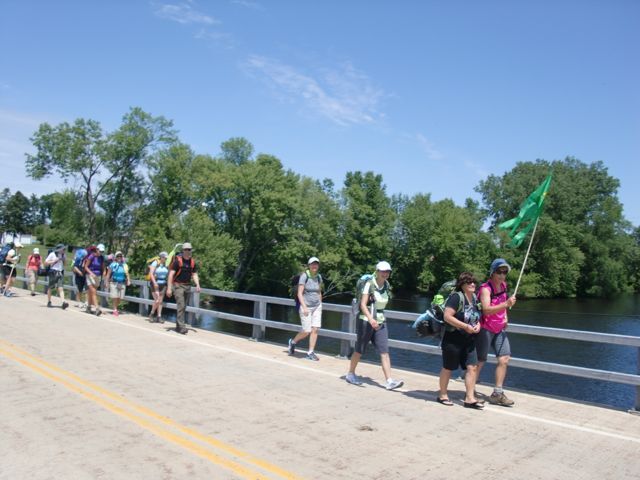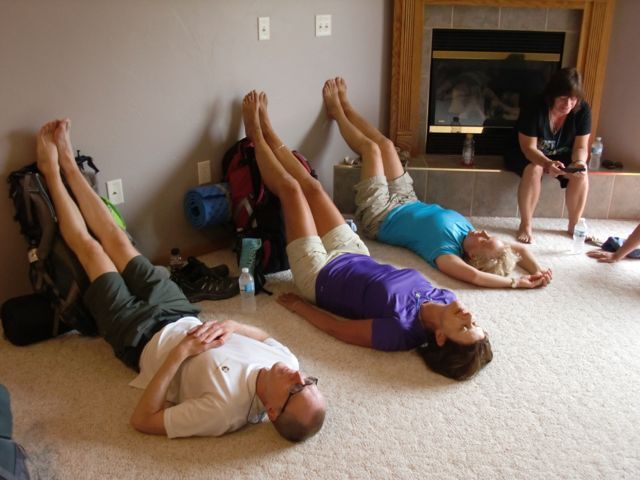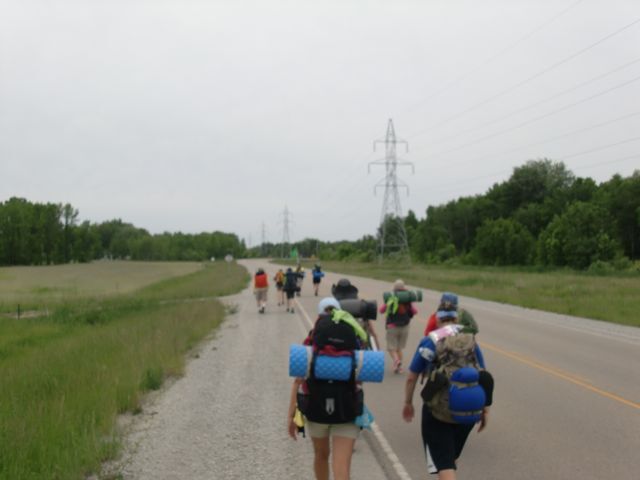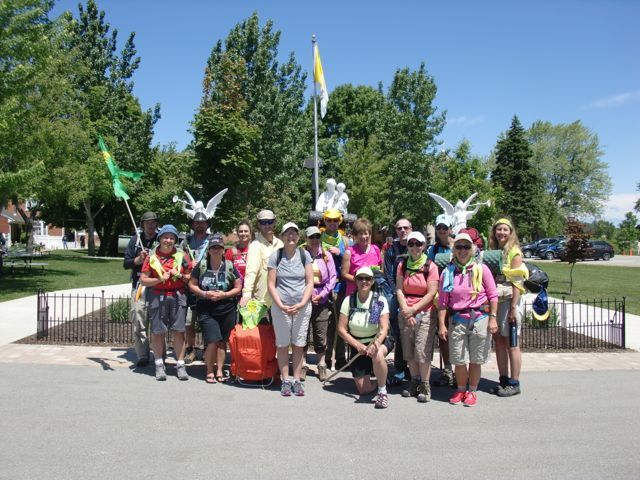This spring my parish just completed our fourth consecutive walking pilgrimage to the Shrine of Our Lady of Good Help. It's the only approved Marian apparition site in North America, and it happens to be a convenient 55 miles from my parishes. It shocked and surprised people when I first told them I wanted to walk to the shrine. Americans simply cannot imagine using their feet to actually transport them somewhere. For most of the history of the world, most humans have relied on their feet to get them where they wanted to go. Feet still work just fine. Even to this day pilgrims plod the famous Camino in Spain to the burial place of St. James. Traveling by foot gives you a new appreciation of the world around you. You experience the land as a living thing and appreciate the places more. One pilgrim told me, "I've lived in Oconto all my life, I've been up and down this road many times, but I can't remember ever seeing that house before." You can go far by taking life one step at a time.
My dream is that some day America will rediscover the ancient practice of walking pilgrimages. I would love to see a walking trail begin at the Cathedral of Green Bay and make its way out to the Shrine. Other trails from around the state could connect important religious sites. Perhaps local communities would open up free hostels where pilgrims could spend a night. People could rediscover a sense of the land and the freedom that feet give you while connecting again with nature and each other. A walking pilgrimage is a surprisingly easy thing to do:
Walk out your front door. Close it behind you. Start walking. When you get to your destination, stop walking.When traveling with a group in America today, you will need to make some plans in advance. Here are seven steps towards making an old-fashioned pilgrimage a success.

Step 1: Choose a route to your destination.
We primarily walk on country roads and secondary roads. I look for sidewalks, public trails and safe intersections. The worst places to walk are the industrial wastelands that we call "business parks." Google Maps can be helpful and so can a good road atlas, but you have to drive, bike, or walk the sections to verify that they actually work. Things look different on the ground and you need to know how to recognize each turn.Step 2: Break it into 12-mile segments.
A pilgrimage should be challenging but not grueling. On the Spanish Camino, the frequent hostels in each town and the closely spaced towns (15-25 km apart) allows you to take things at your own pace. With a group you have to contend with the fact that some travel faster than others. Twelve miles seems to be about what the average American can handle. It's challenging enough for the especially fit but still accessible for more senior pilgrims. I've had pilgrims ages 20s to 60s complete the pilgrimage, and every age in between.Step 3: Find a place to stay each night.
This is harder than you think, especially in rural Wisconsin. The slow pace of walkers means you can't just detour a few miles away to a convenient sleeping location. We mostly sleep in church basements, but we have also slept in friends' houses and even parked campers along our route in advance. I'm opposed to tenting, as it adds extra weight and it's not easy to find camp sites at convenient distances. Besides, begging for a room is a good pilgrim experience. People tend to be generous, and God provides. He doesn't always provide showers, however. Or furniture.
Step 4: Carry your own stuff.
"Why don't you have a car bring your stuff to the next destination?" Wrong idea. The spirit of pilgrimage requires you to carry your own stuff. Most of us need very little - a change of clothes, a sleeping pad, toiletries, rain gear. It starts to add up, though. We carry an average of 15-20 pounds (more with water and food). The stuff that we have is both helpful to us and also weighs us down. This is an important life lesson that should not be missed. Washing your clothes every night in the sink or a washer can really save on weight.Step 5: Figure out the food.
Man does not live on bread alone... but he does need food to live. On the Camino you carry food with you and cook in the hostels or stop at restaurants. All the little towns have little grocery stores where you can pick up supplies. Most of the little mom-and-pop convenience stores that once dotted the land no longer exist, sadly. After considering options we have volunteers deliver bag lunches or cooked meals to our destinations each night. People who can't walk the distance like to be involved in other ways, and really take pride in feeding the pilgrims. The volunteer cooks are so helpful, the biggest problem is too much food.
Step 6: Take your time.
If you live 100 miles from your destination, it will take you 100÷12=8.3 days to complete the pilgrimage. Most planners will look at that and think, "But if I did 20 miles a day, I could make it in 5 days." Big mistake. Pilgrimages are about the journey as much as the destination. Sometimes the experiences along the way are more profound than at the shrine itself. Pilgrimages are about entering into a contemplative mode of existence. The road begins to speak to you, and the world and your life take on new meaning. Life is meant to be savored, and so are pilgrimages. If you cannot spare 8.3 days to complete the pilgrimage, plan it in stages. Do 50 miles this week, and come back in a few months for the next 50 miles. When you try to tackle a 70-mile pilgrimage in 3 days, it becomes a Tour de France instead of a Camino.Step 7: God will provide.
No matter how well you plan, there are always issues. This last pilgrimage we walked right into road construction, including a ripper tearing up the road we were walking on. We got through OK, and as a bonus, the construction workers let us use their port-a-potty. First time pilgrims will be surprised at how often something works out in your favor. Friends of friends hear about the pilgrimage and put out a cooler full of water and juice. People invite you into their homes to use the bathroom. But not all changes are positive. A pilgrim's "most comfortable hiking shoes ever" give him blisters, or someone has to step out for a day to attend a funeral. A walking pilgrimage helps you understand life better. I used to be frustrated by these constant plan changes. Now it is a constant reminder that I'm not alone on the journey. I make my plans relying on the gentle guidance of Another. No one walks this journey alone. ¡Buen Camino!